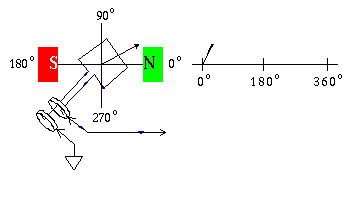
If the first two animated pictures appear frozen, or freeze up after running
a little bit, try moving the mouse, or pressing the shift key by itself.
Failing that, I provide a way to download these two files, so that you can
see what they look like, using an appropriate viewer, not the browser, on your
machine. Some people have reported that the smaller one works on older
browsers while the larger one fails at the first frame, so you might try them
one at a time, if you're having difficulty. Also some older browsers cough
when more than one animation is presented on the same page, and they get real
sluggish.
Also:
Watch the movie first, before starting the lecture, or once the lecture is
running, if it completely freezes, click on the "Reload" button, to get the
movie going again.

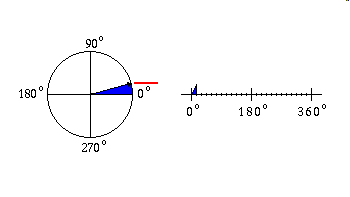
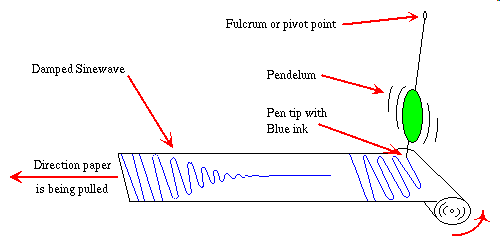
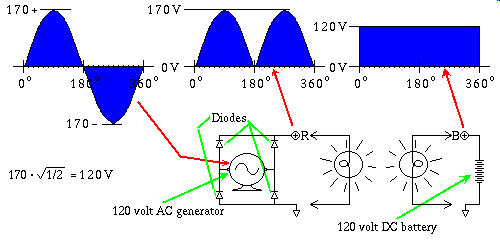
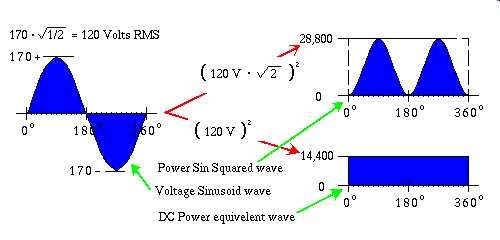
Your Notes:
Mathematical systems of measure used in electronics are devised to make easier
the task of conceptualizing, and grappling with otherwise unwieldy things.
If you think this stuff is needlessly complex, you only have to attempt to
solve a problem requiring Thevenin's Theorem, using the simpler Ohms Law, to
appreciate the tools mathematicians, and engineers have developed over the
years. This is about to get deep, so please bear with me.
What is a radian:
Take a line segment the length of the radius of a given circle, and bend it
to conform to the edge of that circle. The arc formed, measured from it's end
points, and the center of the circle forms approximately, a 57.3 degree angle.
That is a radian. The radian has special properties, 2 times pi times one radian, is
exactly one full 360 degree rotation. The preferred form of representation, of
rotational phenomena, as it relates to AC sinewaves is radian measure.
Thus the irrational number
Pi
(3.1415926xxxxxx...), the term irrational here
means it cannot be expressed as a ratio.
Pi
, and the
Natural Logarithm
are inextricably linked to
representation of voltage, and current, of recurrent sinewaves.
We do this to make easier, the task of handling a continuously
varying periodic repetitive sinewave voltage by thinking of it as a
Magnitude (the length of the vector), and an angle (the vectors phase)
referenced to zero degrees, or zero radians. Good scientific calculators
have a "rad" and "deg" button, for setting the units trigonometric
calculations are carried out in. It is as if, we picture in our mind a
rotating vector of a fixed voltage, as shown in the second animated pictorial,
to represent the more complex sinewave. This lesson Unit 010 is only an
introduction to AC, later I will show you how to work with impedances,
AC resistances that have special rules for dealing with inductors, and
capacitors, that introduce a phasing component into the fundamental
relationship outlined in ohms law. Needless to say, but some may wonder,
whither the rules, such as Thevenins Equivalent learned for DC are of any
use in AC... They are, but with special additional rules.
Since a sinusoidal AC voltage must appear to do the same amount of work,
that is for instance, light a bulb just as brightly, as it's direct current
DC counterpart, and since an AC sinusoid, spends part of it's duration
crossing through zero volts, in order to meet the requirement of lighting
a bulb as brightly as it's DC counterpart, the AC voltage must spend part
of it's duration above it's DC counter part.
At it's positive, and negative peaks, the value of the voltage at those
moments in time, is the stated, or DC counterpart, voltage, multiplied by
the square root of two.
Important Note:
The square root of two, and of one-half as RMS conversions are only
meaningful in the context of sinewaves.
____
/
Peak voltage = Stated-voltage * / 2
\/
The sqrt(1/2) factor is NOT intrinsically related to RMS. It is nothing more
than the result obtained when working through the math for a very special
non-DC waveform - namely a pure sinusoid. If you have a sinusoid with a DC
offset or a triangle wave or square wave you get something other than
sqrt(1/2).
It is interesting to note that the square of a sinusoid is simply a sinusoid
at twice the frequency with a DC offset equal to the peak value of the
original sinusoid. In other words, if you took a sinusoidal waveform and
shifted it upward so that it just barely touched zero at the troughs, you
could not tell the difference between that sinusoid with a DC offset and
waveform that you would get by squaring a separate sinusoid of the same
magnitude but at half the frequency. Hence my illustration in the last
pictorial.
I now state the relationship taught in engineering courses when they
cover RMS conversion, followed by my more precise definition of it.
With the important caveat, that this only applies to a perfectly balanced
Sinusoid, and because a resistor dissipates power equally in both directions
it also applies to a full wave rectified sinewave when fed to a resistor.
RMS voltage = Peak-voltage * RMS
where RMS is a constant approximately = 0.7071
Now my version
____
/ 1
RMS voltage = Peak-voltage * / ---
\/ 2
If it such a special case why do I spend so much effort on it? The reason
has to do the fact that so much of what we do in electronics is based on
Sinewaves, and as a result measurement standards are setup to make things
simpler for the technician making measurements in the field. Your multimeter
probably has an RMS scale for reading AC voltage, but it is up to you to
remember this ONLY applies to sinewaves. The meter, if an electro-mechanical
device is actually not reading RMS, but rather average rectified AC, and it's
even worse than that, due to nonlinearities introduced by the rectifier
diodes inside the meter. So most manufacturers print a "low AC voltage" scale
to deal with this. It is only when you get into the realm of the $500.00
range that you can buy an electro-mechanical special purpose meter, that
directly measures true RMS voltage, by heating a thermocouple. These are
temperamental, eg. easily damaged, low impedance instruments, that are
impractical for routine day to day measurement. Some of the better electronic
digital meters, can read true RMS, using a four quadrant multiplier circuit
but buying one of these, can be a poor choice, especially if the feature
cannot be turned off, because they become inaccurate when reading frequencies
as low as a few tens of kilo hertz, and they're not cheap, the cheap digital
meters read peak voltage, and display it as the RMS equivalent, which is
really stupid! That is partly why I recommend that your first meter be a
simple, easy to understand electro-mechanical device, nothing fancy that
introduces extra complexity.
Background: since the illumination provided by the two lamps is a function
of the Power, "Watts of energy" in each. From an earlier lesson Power is
the arithmetic product of voltage, and current. Specifically for the
purpose of derivation, we will assume that both lamps resistances are the
same, thus power is Voltage squared over a given resistance, and since we
are assuming the resistance is the same in all cases, the resistance falls
out of the equation, when we are talking about the comparison of AC to DC.
If I integrate from zero to any even multiple of 90 degrees, that is solve
for the area under the curve, of the absolute Voltage squared at every point
along sinusoid, the result will be exactly half the area of the Peak voltage
squared, spread over that same, even 90 degree multiple, interval. The
substitute DC voltage mimics our AC voltage, in that, it results in both
lamps providing equal brilliance, and thus, consuming equal wattage.
Note:
Resistors, and by extension, any resistance element, including light bulbs,
treat power the same way irrespective of polarity, that is it makes no
difference which direction the current travels through the resistance element.
This DC voltage is set to a voltage equal to RMS constant multiplied by the
Peak AC voltage. The first of the two equations above. If you were to take
the additional step of squaring, the DC equivalent of this RMS AC voltage,
in this case a sinusoid, whose Peak value is 170 volts, and if you like,
dividing it by the resistance to get Power, then set that result aside,
labeling it "DC Power". Next, compute the area under the curve for the Power
Waveform that results, when you square the voltage of the sinewave,
Note:
A squared sinewave does not look like the original Sinusoid, I show
an approximation of a squared sinewave in the last of the above pictorial
illustrations. If you look at the Squared Sinewave, it has as much light
area, as it does dark area, in this case "blue filled" area. Remember these
squared voltage waveforms represent Power. Since exactly half of the area is
under the curve, this makes the Power consumed by a pure resistance, in this
case a light bulb, exactly the same, whither powered by the AC source, or by
our DC equivalent that is fully filled in, but only half as tall.
The notion of solving for the area under the curve, is a calculus method, and
I promised not to make this course depend on higher math, but I did say that
you would be expected to learn what the calculus is for.
The Damped Sinusoid:
Strike, a tuning fork, ring a bell, or pulse an LC resonant circuit, the
result is a sinewave that starts out loud, eg. high amplitude sinewave,
that, because of frictional losses, and or other inefficiencies, slowly
degrades over time, to a point that the amplitude tapers down to, what
appears to be nothing. In a theoretical sense it is still running, and still
tapering down, getting smaller and smaller, in a practical sense, at some
point the random motion of atoms is so large by contrast that measurement
of the decaying sinewave is ultimately impossible.
I show a depiction of a paper roll that as it is unwinding, a pendulum is
scribing such a decaying sinewave onto the paper, "Strip Chart Style"
the point to be made here, is that sinewaves, whither of the decaying
type, or of a the type denoted by a maintained power input, such as the
generator example, in the first frame, are common in nature, and exist
everywhere around us.
Describing the decaying sinewave in mathematical terms, borrows two concepts
from transcendental arithmetic, the Sinusoid, and negative exponents to
describe the rate of decay, both of these will be covered in in greater
detail when I discuss Capacitor, and inductor, time constants.
It is worthy to note if you're not a quick study of algebra, that the RMS
constant and the square root of two, are reciprocals of each other.
Ponder why this is, and you will gain a much deeper understanding of how
fractions inside powers, and roots, relate to each other. Most people
entertaining the idea of learning any scientific discipline have a good
scientific calculator. If algebra scares you, try to learn how numbers
relate to one another, by trying relationships out on the calculator, you
will develop the precepts of algebra as you need them.
Hints:
Or things you should be pondering / getting familiar with:
Try these on your calculator
Why does a number raised to a reciprocal
of X solve for the Xth root of that number
Example:
____
16^(1/2) = \/ 16
You can raise a number to a fractional
power as well
Example:
__________
16^(3/2) = \/ (16^3)
You can also raise a number to a
negative power.
2^+5 = 32 = 2 * 2 * 2 * 2 * 2
2^-5 = 0.03125 = 1 / 2 / 2 / 2 / 2 / 2
Any number multiplied by itself always results in a positive number, so how
would you get the square root of a negative number, eg. what number squared
equals negative 16? I will provide terse coverage of this when I discuss a
kind of short hand, for dealing with AC impedances that involves what are
called Imaginary Numbers when I revisit AC after covering RC, and RL
time constants
In the lecture I introduce the a circuit called a Diode Bridge, Diodes are
devices that conduct electricity in only one direction, I show below using
ascii art, a pictogram of the flow of current for both polarities of the
alternating current.
This is the full circuit
---------------------------> to load
| |
--- ---
/^\ ___ /^\
| / \ |
+--------( GEN )-------+
| \___/ |
--- ---
/^\ /^\
| | return
---------------------------> from
load
This is the first half
cycle, eg. 0 - 180 degrees
---------------------------> to load
|
---
___ /^\
Neg / \ Pos |
+--------( GEN )-------+
| \___/
---
/^\
| return
---------------------------> from
load
This is the second half
cycle, eg. 180 - 360 degrees
---------------------------> to load
|
---
/^\ ___
| Pos / \ Neg
+--------( GEN )-------+
\___/ |
---
/^\
| return
---------------------------> from
load
Start, and maintain a notes file on your computer, and learn how to save that
file onto a floppy, in a form that you can take it to any machine and readily
read your notes. By that I mean, if you use a word processor, and that
word processor saves the file out in some proprietary format that can only be
read by your machine find some other tool, perhaps a simple DOS text editor,
or Learn Linux, the point is I want this data that you create in learning
this course, to transcend the current generation of computers, and software.
Simple ASCII text will always be supported, atleast for any english system.
You should learn to save your critical files, first in simple ASCII, and then
if you wish to include the proprietary formatting, under a different
subdirectory on the floppy, go ahead. The reason I state this so
emphatically, is that all computer operating systems eventually crash, yes
contrary to what you may have heard, even Linux goes down once in a while,
although that's quite rare, if you have backups of your critical stuff, in a
form that can be read anywhere, eg. not dependent on some proprietary
software, that goes out of business tomorrow, and when you get the new version
of what ever Operating System comes out next year, you find that you can't buy
brand X and all of your custom formatted critical data is useless junk. If you
take this approach now while you have the choice, your reward will be a
lifetime of information that you never have to carry around in your brain.
This can be incredibly empowering, the computer is now serving as an extension
of your brain. Some would argue, that this opens you up to privacy invasion,
hey, if someone gets hold of your files, they own you. If that is a concern,
learn how to use encryption, there are many programs available on the net,
some good some not so good, but if you choose to encrypt, be sure you can
decrypt tomorrow! Meaning, make sure the encryption program is Open Source
and that you have a copy of the source code, even if you can't read C or Perl,
or haven't clue how to write DOS Batch files, someone, somewhere, should the
need arise, can get your encryption program running on what ever computer
tomorrow brings, assuming you saved the Source Code. In any case, any fear
of loosing your privacy, should not be used as an excuse for failing to take
and maintain adequate notes. To add to this issue, you may have heard of
Court Orders requiring people to hand over the password to their encrypted
files. Steagonography eliminates this threat, it stops it cold! You have
mp3 music, and jpeg image files on your system, right? What Steagonagraphy
does, is sprinkle into one or more of these files of your choice, in such
a way as not to degrade the quality of the sound, or the image, they do this
by replacing noise, with, encrypted data. The result is a perfectly usable
sound, or picture file, that has data embedded in it, that only becomes
visible with the encryption key. And here's the best part, such a file, in
the hands of an intruder, yields no clue, that any secret data is embedded
inside it. So if you don't tell anyone that Hard_Days_Night.mp3 contains
secret hidden data, there is no way they can detect that it does, and thus
even if you are ordered to surrender crypto keys, if you fail to mention
the key that unlocks that file, they can't prove it holds any encrypted
info. You simply say what key, I don't see any key, you must be imagining
things, that's just an illegal copy of the Beatles Hard Days Night, and
nothing more.
Note: This only applies to analog audio recording, subsequently processed
into digital, and then into Mpeg. If you rip a CD, and then take the
dot wav file into Mpeg format, reversing the process produces a dot
wav file, whose data can be compared to another identical dot wav file
ripped from an identical audio CD. Comparing these two, should if no
hidden data is present, present only artifacts of the Mpeg compression
algorithm. Analog recordings, taken into digital, aka dot wav files,
are at the least significant bits, pure noise, making them kind of
like snow flakes, eg. no two are ever alike. Scanning photographs is
also an analog phenomenon, especially if you destroy the original
photograph. If the would be Spooks went to the site where the photo
was originally shot, changes in shading, due to light source position,
and dust accumulation on surfaces, would make it impossible to reproduce
a pattern master close enough to the original to make such a determination.
This is ignoring the theory, behind this burgeoning science, usually
mistakes are what gives away the store, rather than the cryptosystem itself.
To avoid these mistakes requires a working knowledge of the whole process
on the part of the user. I have offered only one of many of the pitfalls
to this complicated field, if you intend to use it to protect yourself, plan
on doing some extensive research.